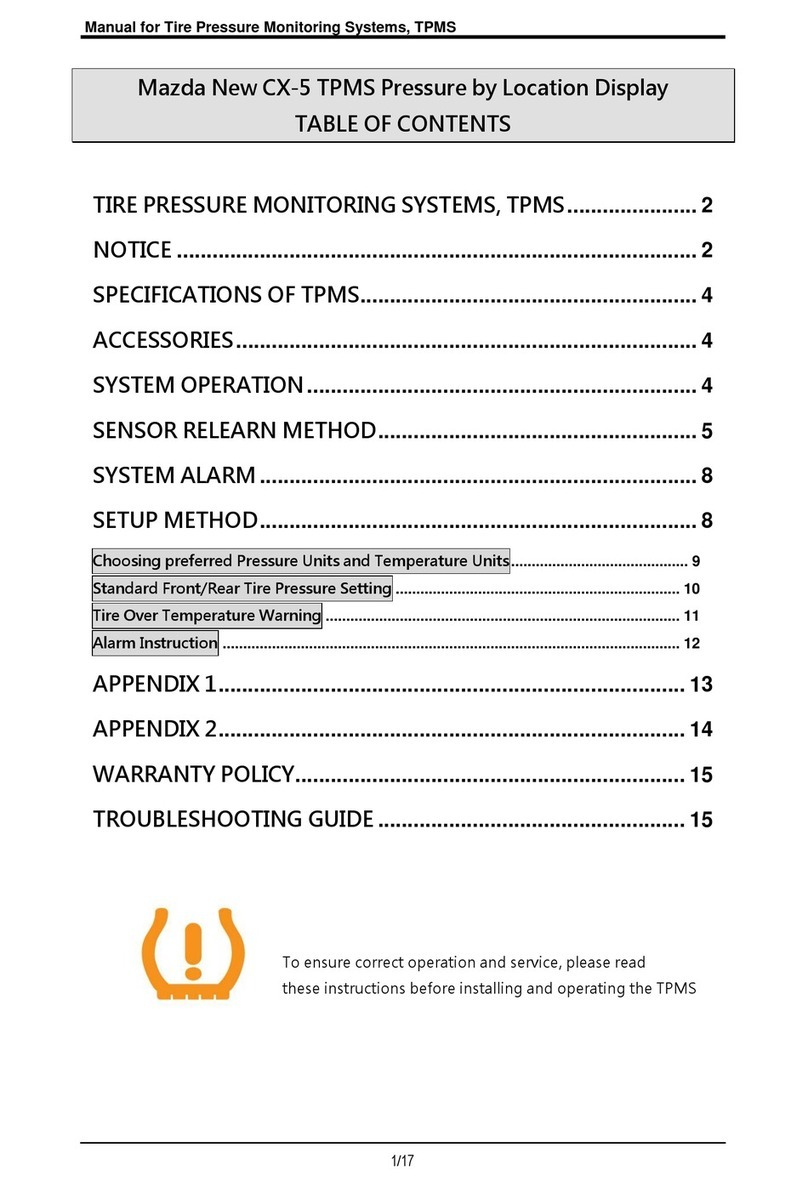Manual for Tire Pressure Monitoring Systems, TPMS
2/22
Tire Pressure Monitoring Systems, TPMS
Tire Pressure Monitoring Systems (TPMS) improves safety while driving. Once installed in your
vehicle, the system will automatically monitor your tires in real-time for pressure and
temperature. When any tire’s pressure and/or temperature appear abnormal, the system will, in
real-time, transmit signals to active an alarm and show a digital figure to warn the driver of a
problem. The system aids safety, can extend the tire life and help reduce fuel consumption.
NOTICE
FCC Notice
This device complies with Part 15 of the FCC Rules. Operation is subject to the following two
conditions: (1) this device may not cause harmful interference, and (2) this device must accept
any interference received, including interference that may cause undesired operation.
This equipment has been tested and found to comply with the limits for a Class B digital device,
pursuant to Part 15 of the FCC Rules. These limits are designed to provide reasonable
protection against harmful interference in a residential installation. This equipment generates
uses and can radiate radio frequency energy and, if not installed and used in accordance with
the instructions, may cause harmful interference to radio communications. However, there is
no guarantee that interference will not occur in a particular installation.
If this equipment does cause harmful interference to radio or television reception, which can be
determined by turning the equipment off and on, the user is encouraged to try to correct the
interference by one or more of the factoring measures.
Reorient or relocate the receiving antenna.
Increase the separation between the equipment and receiver.
Connect the equipment into an outlet on a circuit different from that to which the receiver
is connected
Caution: Any changes or modifications in construction of this device which are not expressly
approved by the party responsible for compliance could void the user’s authority to operate the
equipment.
To comply with the FCC RF exposure compliance requirements, this device and its antenna
must not be co-located or operating to conjunction with any other antenna or transmitter.
System Scope of Use and Warnings
Tire Pressure Monitoring System, TPMS
This system is a sensing device designed to measure and display tire operation and / or
activate an alert to the driver when pressure and temperature irregularities are detected. It is
the responsibility of the driver to react promptly and with discretion to alerts. Abnormal tire
inflation pressure should be corrected at the earliest opportunity.
Caution: The system is wireless RF product; therefore, it may not receive signal due to
interference environment or incorrect operating or installation. When the system continually
cannot receive signal from one of the tire sensor more than 20 minutes since the system be
switched on, the system will show “ E2 ”. In this case, it may cause by a RF interference
environment and driver needs to drive the vehicle to other place. If the display still cannot
receive any correct signal from tire sensor, then, driver needs to find a nearby qualified tire
maintain service for checking and maintain. It may cause by a tire sensor damaged or battery
power consumption is low (the battery consumption will be lower than under normal using
condition due to sensors need to send warning signal continually to driver) . If the system
continually cannot receive signal from any sensors more than 20 minutes, the system might
damaged and will show “E1”. Driver needs to drive to other place (there might be a
interference nearby) or send the system to agent for repair
*System Installation and Usage
Use of the TPMS requires that qualified personnel according to the instructions here have
properly installed it. This system is suitable for use on a passenger car, SUV and 4X4 tires,
with up to maximum cold inflation pressure of 74 Psi (Gauge), below instruction is Gauge value
mentioned.






























